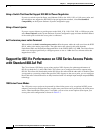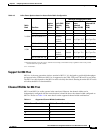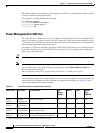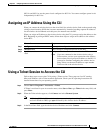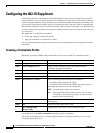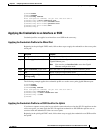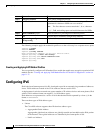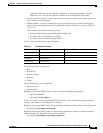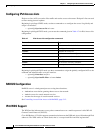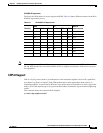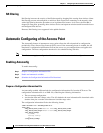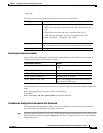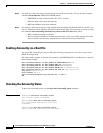
4-30
Cisco IOS Software Configuration Guide for Cisco Aironet Access Points
OL-30644-01
Chapter 4 Configuring the Access Point for the First Time
Configuring IPv6
Beginning in privileged EXEC mode, use the following command to assign a site-local or global address
to the interface:
ap(config-if)# ipv6 address ipv6-address [eui-64]
Note The optional eui-64 keyword is used to utilize the Modified EUI-64 interface ID in the low order 64 bits
of the address.
Configuring DHCPv6 address
DHCPv6 is a network protocol that is used for configuring IPv6 hosts with IP addresses, IP prefixes and
other configuration required to operate on an IPv6 network. The DHCPv6 client obtains configuration
parameters from a server either through a rapid two-message exchange (solicit, reply), or through a
normal four-message exchange (solicit, advertise, request, reply). By default, the four-message
exchange is used. When the rapid-commit option is enabled by both client and server, the two-message
exchange is used.
Beginning in privileged EXEC mode, use these commands to enable the DHCPv6 client in an Access
Point:
–
ap# conf t
–
ap(config)# int bv1
–
ap(config)# ipv6 address dhcp rapid-commit(optional)
Autonomous AP supports both DHCPv6 stateful and stateless addressing.
Stateful addressing
Stateful addressing uses a DHCP server. DHCP clients use stateful DHCPv6 addressing to obtain an IP
address.
Beginning in privileged EXEC mode, use this command to configure stateful addressing:
ap(config)# ipv6 address dhcp
Stateless addressing
Stateless addressing does not use a DHCP server to obtain IP addresses. The DHCP clients autoconfigure
their own IP addresses based on router advertisments.
Beginning in privileged EXEC mode, use this command to configure stateless addressing:
ap(config)# ipv6 address autoconfig
IPv6 Neighbor Discovery
The IPv6 neighbor discovery process uses ICMP messages and solicited-node multicast addresses to
determine the link-layer address of a neighbor on the same network.
Beginning in privileged EXEC mode, use these commands to configure IPv6 neighbor discovery:



